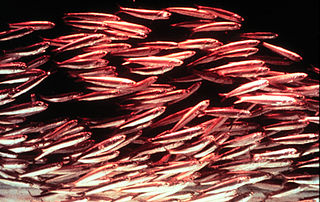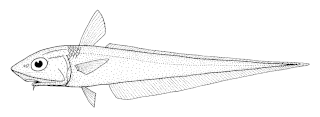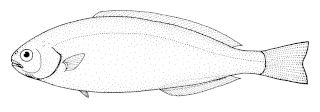
The Australasian gannet, also known as Australian gannet and tākapu, is a large seabird of the booby and gannet family, Sulidae. Adults are mostly white, with black flight feathers at the wingtips and lining the trailing edge of the wing. The central tail feathers are also black. The head is tinged buff-yellow, with a pale blue-grey bill edged in black, and blue-rimmed eyes. Young birds have mottled plumage in their first year, dark above and light below. The head is an intermediate mottled grey, with a dark bill. The birds gradually acquire more white in subsequent seasons until they reach maturity after five years.

The Peruvian anchoveta is a species of fish of the anchovy family, Engraulidae, from the Southeast Pacific Ocean. It has yielded greater catches than any other single wild fish species in the world, with annual harvests varying between 4.2 and 8.3 million tonnes in 2008–2012. Almost all of the production is used for the fishmeal industry. The Peruvian anchoveta may be the world's most abundant fish species.

The Australian bonito, horse mackerel or little bonito, Sarda australis is a fish of the family Scombridae and is found in eastern Australia and New Zealand. They swim at depths reaching depths of approximately 30 m (98 ft), in open water. Its length is commonly at around 40–45 centimetres (16–18 in) fork length and 1.8–2.3 kilograms (4.0–5.1 lb) weight. Its maximum length and weight are about 100 centimetres (39 in) and 9.4 kilograms (21 lb), respectively.

Engraulis is a genus of anchovies. It currently contains nine species.

The javelin, javelinfish, or southern whiptail, Coelorinchus australis, is a species of rattail found around Australia and New Zealand at depths of between 80 and 500 m. Its length is between 25 and 50 cm. It is a brownish color with 8 or 9 pale longitudinal stripes, and a small chin barbel. It feeds on octopus, fishes, and decapod crustaceans.

The southern driftfish or ragfish, Icichthys australis, is a medusafish of the genus Icichthys found around the world in all southern oceans between latitudes 50° S and 60° S, from the surface down to 2,000 m. Its length is from 35 to 80 cm.

The southern blue whiting is a codfish of the genus Micromesistius, found in the southern oceans with temperatures between 3 and 7 °C, at depths of 50 to 900 m. Its length is commonly between 30 and 60 cm, with a maximum length of 90 cm. Maximum weight is at least 1350 g.
The Argentine anchoita or Argentine anchovy is an anchovy of the genus Engraulis, found in and around waters of Argentina, Uruguay and southern Brazil.

CalCOFI is a multi-agency partnership formed in 1949 to investigate the collapse of the sardine population off California. The organization's members are from NOAA Fisheries Service, Scripps Institution of Oceanography, and California Department of Fish and Wildlife. The scope of this research has evolved into the study of marine ecosystems off California and the management of its fisheries resources. In 2004, the CalCOFI survey area became one of 26 LTER research sites. This time-series of oceanographic and fisheries data allows scientists to assess the human impact and effects of climate change on the coastal ocean ecosystem. CalCOFI hydrographic & biological data, publications, and web information are distributed for use without restriction under the terms of the GNU Free Documentation License.

Myeolchi-jeot (멸치젓) or salted anchovies is a variety of jeotgal, made by salting and fermenting anchovies. Along with saeu-jeot, it is one of the most commonly consumed jeotgal in Korean cuisine. In mainland Korea, myeolchi-jeot is primarily used to make kimchi, while in Jeju Island, meljeot is also used as a dipping sauce. The Chuja Islands, located between South Jeolla and Jeju, are famous for producing the highest quality myeolchi-jeot.

The European anchovy is a forage fish somewhat related to the herring. It is a type of anchovy; anchovies are placed in the family Engraulidae. It lives off the coasts of Europe and Africa, including in the Mediterranean Sea, the Black Sea, and the Sea of Azov. It is fished by humans throughout much of its range.
The Southern African anchovy is a species of anchovy which occurs in the southeast Atlantic Ocean near Namibia and South Africa.
The stable ocean hypothesis (SOH) is one of several hypotheses within larval fish ecology that attempt to explain recruitment variability. The SOH is the notion that favorable and somewhat stable physical and biological ocean conditions, such as the flow of currents and food availability, are important to the survival of young fish larvae and their future recruitment. In the presence of stable ocean conditions, concentrations of prey form in stratified ocean layers; more specifically, stable ocean conditions refer to “calm periods in upwelling ecosystems ” that cause the water column to become vertically stratified. The concept is that these strata concentrate both fish larvae and plankton, which results an increase of the fish larvae feeding because of the density-dependent increase in predator-prey interactions. Lasker is attributed with constructing this hypothesis in the late 1970s by building on previous larval fish research and conducting his own experiments. He based the SOH on case studies of clupeid population fluctuations and larval experimentation.

Ichthyoplankton are the eggs and larvae of fish. They are mostly found in the sunlit zone of the water column, less than 200 metres deep, which is sometimes called the epipelagic or photic zone. Ichthyoplankton are planktonic, meaning they cannot swim effectively under their own power, but must drift with the ocean currents. Fish eggs cannot swim at all, and are unambiguously planktonic. Early stage larvae swim poorly, but later stage larvae swim better and cease to be planktonic as they grow into juveniles. Fish larvae are part of the zooplankton that eat smaller plankton, while fish eggs carry their own food supply. Both eggs and larvae are themselves eaten by larger animals.

The Japanese anchovy is a schooling fish of the family Engraulidae. It is common in the Pacific Ocean south from the Sea of Okhotsk, widespread in the Sea of Japan, Yellow Sea, and East China Sea, and near the coasts of Japan. They live up to 2–3 years, similar to European anchovy. They spawn from Taiwan to southern Sakhalin.

The Great South Australian Coastal Upwelling System is a seasonal upwelling system in the eastern Great Australian Bight, extending from Ceduna, South Australia, to Portland, Victoria, over a distance of about 800 kilometres (500 mi). Upwelling events occur in the austral summer when seasonal winds blow from the southeast. These winds blow parallel to the shoreline at certain areas of the coast, which forces coastal waters offshore via Ekman transport and draws up cold, nutrient-rich waters from the ocean floor.

Anchovies are small, common salt-water forage fish in the family Engraulidae. There are 144 species in 17 genera, found in the Atlantic, Indian, and Pacific Oceans. Anchovies are usually classified as an oily fish. They are small, green fish with blue reflections due to a silver longitudinal stripe that runs from the base of the caudal fin. They range from 2 centimetres (0.79 in) to 40 centimetres (16 in) in adult length, and the body shape is variable with more slender fish in northern populations.

The California anchovy or northern anchovy is a species of anchovy found in the Pacific Ocean, ranging from Mexico to British Columbia.

Anchovy paste is a fish paste food product prepared using anchovies as a primary ingredient. It is used as a condiment and as an ingredient in various dishes, such as Scotch woodcock, and is a mass-produced product. It has been used for centuries to provide flavor to foods and as a source of nutrients, and it is a part of the cuisines of Great Britain, Italy, the Philippines and Vietnam. It is a major export product of Morocco.



















